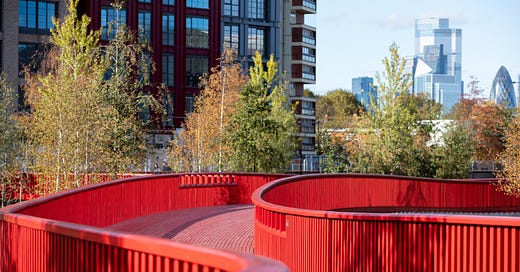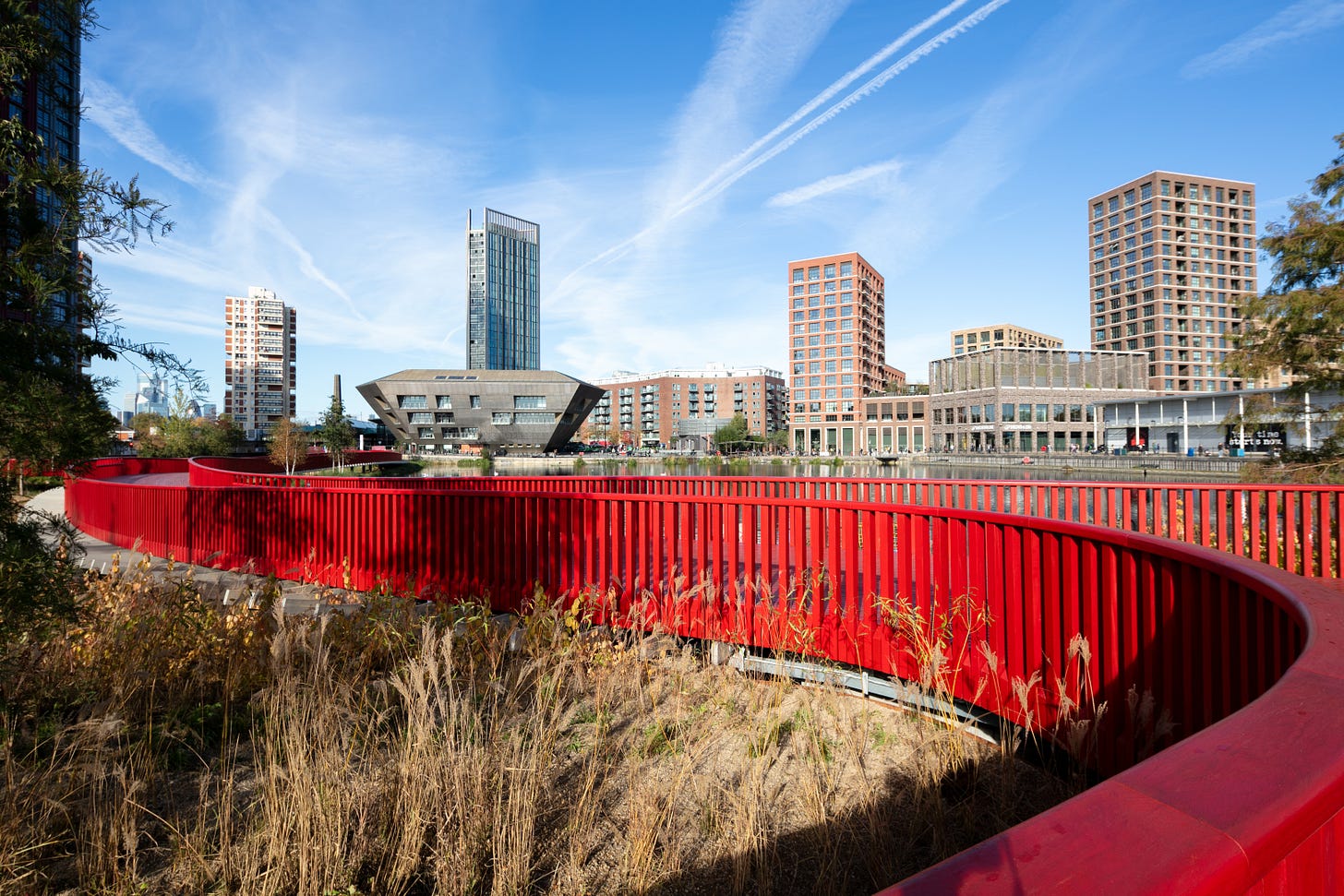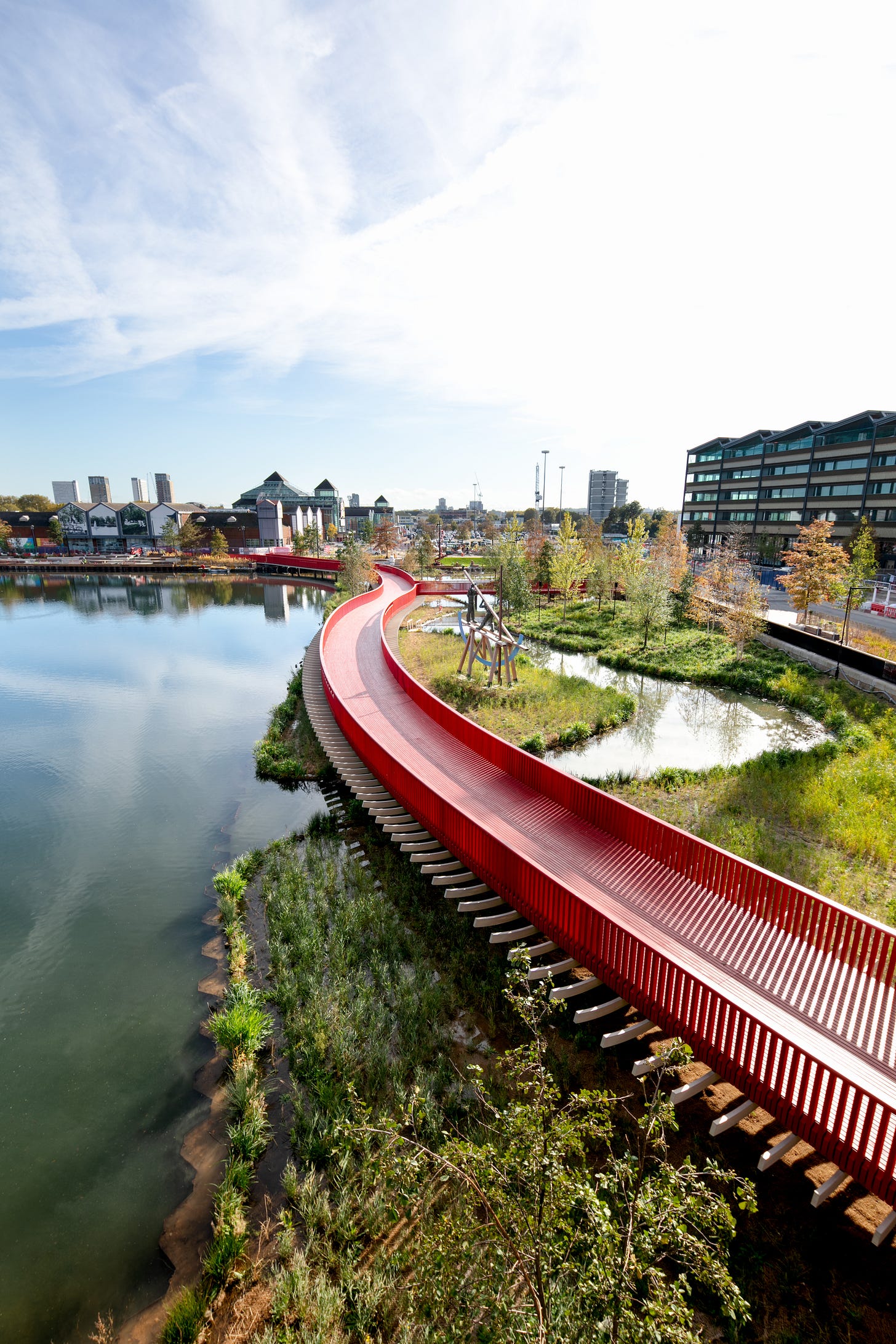How a bright red boardwalk became the overnight star of a £4bn show
A ruby-hued wooden walkway undulating through London's "first new town centre" in 50 years is proving how purposeful public realm can set a new standard for global neighbourhood design
Bold, arresting and unexpected, an 170m-long crimson boardwalk has become the jewel in the crown of one of London’s most ambitious regeneration schemes.
Weaving gently through the Wetlands at the heart of British Land’s sprawling, 53-acre Canada Water redevelopment flanked by reeds and other waterside planting, the Asif Khan-designed walkway officially launched last weekend. And it is so much more than a crossing from one side of the site’s basin to the other.
It is a beautiful piece of public art, a visitor experience, a natural habitat for wildlife, a masterclass in the use of sustainably sourced (and sustainably dyed) materials and an homage to the area’s history - the boardwalk crosses waters once used by ships carrying cargo from the Atlantic and it’s colour is a nod to the red pine brought into the London docks from Canada in Victorian times.
It is also a glimpse into the future of neighbourhood design more broadly. Canada Water’s walkway isn’t a landmark for the sake of being a landmark. It has a role to play - a plethora of roles actually, as detailed above. It anchors the £4bn scheme not by being the biggest, tallest, most valuable office building on the site - or any private space on the site for that matter - but simply by virtue of being visible and accessible to all.
“Not everyone will use the buildings you develop,” says British Land’s Michael Delfs an urban designer and development executive on the Canada Water scheme. “But everyone will use your public realm. That’s why we have chosen to lead here not with just good, but with really amazing public space.”
At a time when a commitment to sustainable, purposeful public realm that puts people and nature at its heart has never been more valued, there is a lot to be learnt from this punchy red boardwalk.
Setting an intention
British Land and AustralianSuper’s Canada Water masterplan will be over a decade in the making. When completed, it will deliver around 1 million sq ft of new retail, leisure and education space, up to 2 million sq ft of workspace for 20,000 workers and between 2,000 and 4,000 new homes.
Promises have been made, goals have been set and work is underway. But a lot can, and will, change over the course of ten years. Markets will shift, tenant demand will evolve and financial cycles will ebb and flow. “Over the last 20 years, the idea that really good mixed-use development is more valuable than the sum of its parts has become well understood,” says British Land’s Delfs. “What is less well understood is how long it takes. These projects are measured in decades, not years. We need to have faith in the vision and maintain belief as the world around us changes. It’s not easy.”
Not least when it comes to public perception and support. A decade is a long time to wait to see any significant progress on a huge expanse of land - particularly from the outside looking in.
This is where elements like the boardwalk can play a critical role. A red timber bridge may seem like a small, comparably insignificant piece of a wider multi-billion pound regeneration puzzle. In fact, the opposite is true. It sets an intention to deliver on assurances made - not just around commercial and private assets, but about what the site will ultimately stand for.
The delivery of the walkway is a commitment to prioritising sustainable public realm and a significant step towards creating a place that, in the words of British Land’s joint head of Canada Water Roger Madelin, “will give people a reason to visit the site on a rainy Sunday.” Or, indeed, a sunny one.
In addition to that, he adds, it helps people to better understand the overarching vision for the project. “I can see it [the vision],” he says. “My colleagues can see it. But most people would rather physically touch something. Putting something here on the site to be able to show people what we stand for is very important.
“We thought, what can we do to the dock to make it a place where people can connect with nature? So we envisioned a boardwalk on it and recreated the wildlife habitat next to it. We want people to come here because of the public realm.”
The power of purpose
So, will the punchy red walkway that has already captured the interest and attention of so many remain the jewel in Canada Water’s crown as development continues around it? I certainly hope so.
It is different, fun, playful - all qualities to be heartily and enthusiastically lauded. But, more than that, it has a reason for being that goes beyond delivering much needed human-centred public realm. Khan’s bridge doesn’t just serve the people. It supports the natural world, it celebrates London’s history and it showcases the power and beauty of sustainably sourced materials.
That’s how you do a landmark.
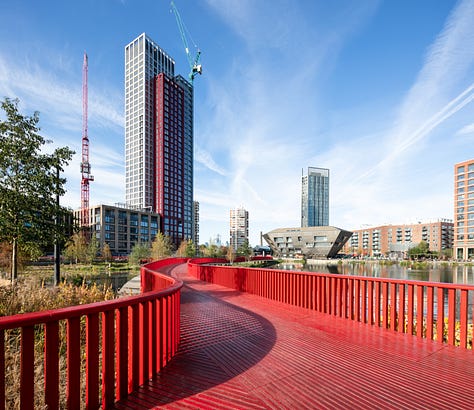
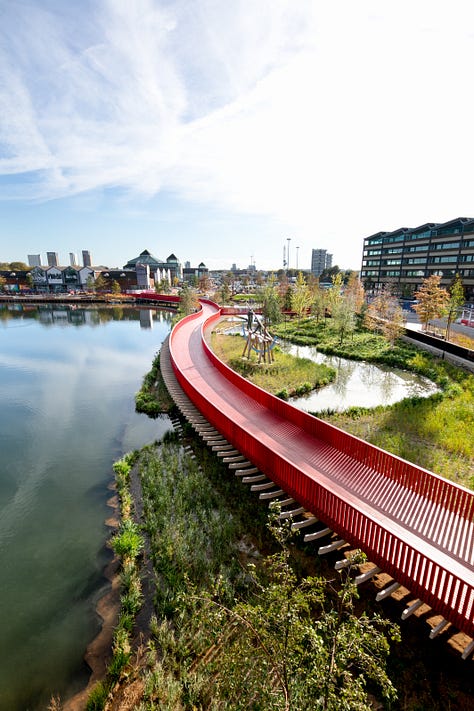
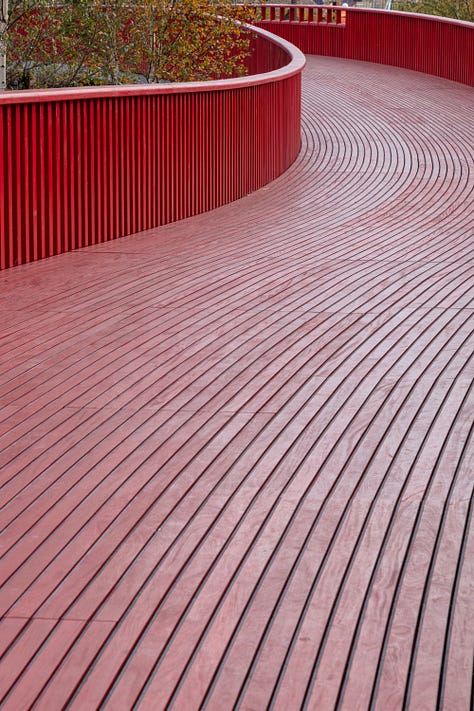
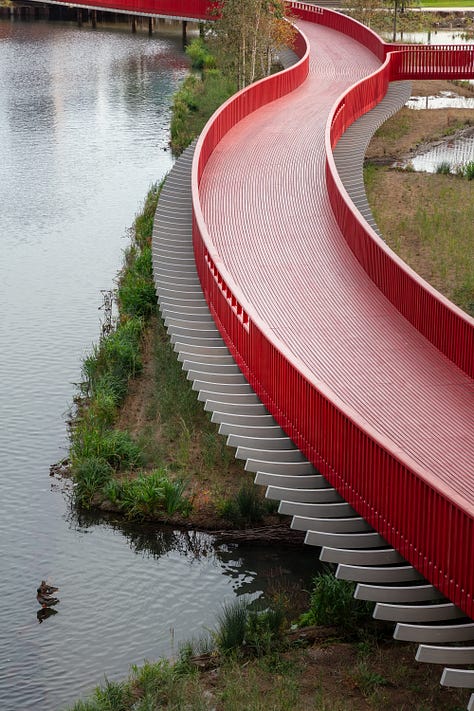
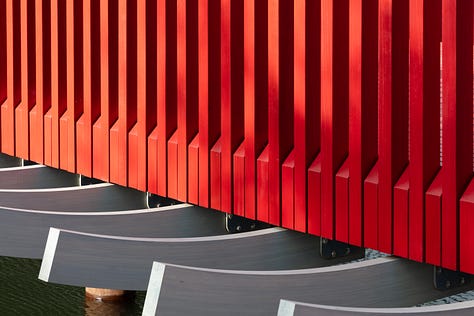

This is the first in a two-part Well-Placed series on neighbourhood development. The second instalment will feature a full interview with Roger Madelin, British Land’s joint head of Canada Water and the former CEO of Argent where he led the delivery of London’s 56-acre King’s Cross redevelopment. Subscribe to Well-Placed for free below to be sure not to miss Part 2.
For more on what it takes to anchor long-term developments, check out the inaugural Global Smart Neighbourhood Summit hosted by WiredScore, the organisation that sets the global standard for technology in the built world through certification.
Last month’s summit brought together a number of major players delivering large-scale projects around the world from Vancouver to Saudi Arabia and from London to Singapore. They lifted the lid on how they are future-proofing new neighbourhood designs across the globe by focussing on technology and - you guessed it - purposeful public realm.
WiredScore’s accompanying Global Smart Neighbourhoods White Paper set out how neighbourhood schemes that will stand the test of time will be those that “invest as much in shared community spaces and amenities as they do in the buildings themselves and place equal emphasis on the sustainability of both the community and its technical infrastructure.”
Emily Wright is a real estate, architecture and technology journalist contributing to titles including Wallpaper*, WIRED, GQ, The Spaces, The Evening Standard, The Times and The Telegraph. She spent 12 years of her career at EG where she worked as both tech editor and then head of content. She has interviewed major players from both within and outside the property industry including Zaha Hadid, Sidewalk Labs' Dan Doctoroff, Lord Richard Rogers, Daniel Libeskind, Donald Trump and Sir Terence Conran.
Emily is now head of content at CREtech where she specialises in curating content and interviewing speakers from across the built world with a focus on innovation and sustainability. She is also a contributing editor, moderator and keynote speaker focussed on design, development, cities, innovation and ESG.

